The ecologist’s view of bird flu Understand article
Are migratory birds responsible for the spread of bird flu? Should we kill them all? Lucienne Niekoop and Froukje Rienks from the Netherlands Institute of Ecology argue for a more scientific approach.
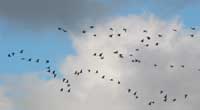
each year, but are they
spreading bird flu?Millions of
lorries carrying poultry
travel roads around the
world…
Images courtesy of Jan Visser,
NIOO-KNAW
“Kill all migratory birds.” With this controversial statement, Russian politician Vladimir Zjirinovski caused widespread consternation in January 2006, when the bird flu virus was spreading rapidly. The big question, however, is which birds are to blame. By addressing this question, ecological research can play a key role in the understanding of avian flu.
An overview
In mid-2003, the H5N1 bird flu outbreak began in south-east Asia. We do not yet fully understand how this virus spreads, but to prevent a pandemic, it is important to take a multidisciplinary approach. Ecologists from the Netherlands Institute of Ecologyw1 are co-operating closely with virologists at the Erasmus Medical Centre in Rotterdamw2, the Netherlands, to understand the role of migratory birds in the transmission of bird flu.
Lethal subtypes
First, let us go back to bird flu basics. Viruses, small pieces of RNA or DNA covered in a protein coat, occur in many forms. Flu is caused by the influenza virus, which has three types: A, B, and C, all of which can infect humans. Bird flu (avian influenza) is caused by influenza A viruses, for which birds form the reservoir.
There are several subtypes of influenza A. The severe virus that is currently spreading has the codename H5N1, derived from the membrane proteins on the virus particle. H5 stands for the haemagglutinin type 5 membrane protein (there are 16 types in total). Neuraminidase is the full name of the membrane protein N, of which there are nine variants. Different combinations of the H and N membrane protein types result in many virus subtypes. Subtypes may be harmless, in which case they are known as low pathogenic avian influenza (LPAI) viruses. Harmful or lethal subtypes are classed as highly pathogenic avian influenza (HPAI) viruses.
| H1 | H2 | H3 | H4 | H5 | H6 | H7 | H8 | H9 | H10 | H11 | H12 | H13 | H14 | H15 | H16 | |
|---|---|---|---|---|---|---|---|---|---|---|---|---|---|---|---|---|
| N1 | ||||||||||||||||
| N2 | ||||||||||||||||
| N3 | ||||||||||||||||
| N4 | ||||||||||||||||
| N5 | ||||||||||||||||
| N6 | ||||||||||||||||
| N7 | ||||||||||||||||
| N8 | ||||||||||||||||
| N9 |
| H1 | H2 | H3 | H4 | H5 | H6 | H7 | H8 | H9 | H10 | H11 | H12 | H13 | H14 | H15 | H16 | |
|---|---|---|---|---|---|---|---|---|---|---|---|---|---|---|---|---|
| N1 | ||||||||||||||||
| N2 | ||||||||||||||||
| N3 | ||||||||||||||||
| N4 | ||||||||||||||||
| N5 | ||||||||||||||||
| N6 | ||||||||||||||||
| N7 | ||||||||||||||||
| N8 | ||||||||||||||||
| N9 |
Global outbreak
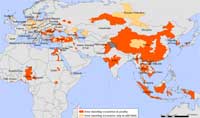
reported in poultry or wild
birds in many areas
(situation on 12 September
2006)
Image courtesy of the World
Health Organization
Usually, influenza viruses do not cross the species barrier, which means that different species of organisms cannot pass the infection from one to another. However, the highly pathogenic bird flu H5N1 has been shown to jump from birds to humans, although not easily. In the recent outbreak, there have been at least 256 human cases, of whom more than half died (as of 16 October 2006), according to the World Health Organization (WHO)w3. Nonetheless, the WHO states that this is a small number compared with the huge number of birds affected.
The H5N1 virus has been shown to spread from human to human only sporadically, as a result of intensive contact. However, because the virus mutates rapidly, researchers all over the world predict that the H5N1 virus will eventually merge with a human-specific influenza virus. The resulting highly pathogenic germ could then disperse freely from person to person and result in a global outbreak or pandemic.
Faeces
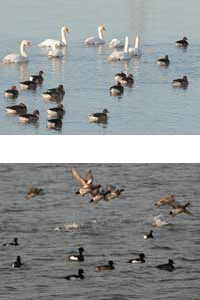
It is likely that all species of birds can become infected with avian influenza. Affected birds secrete the virus in high concentrations in their faeces, and the main known infection route is oral intake of these contagious faeces. Waterfowl like ducks, geese and swans seem to be among the most infected species of birds and form a natural reservoir of all influenza viruses, usually the low pathogenic forms. Jan van Gils, an ecologist at the Netherlands Institute of Ecology, explains: “Notably water-foraging birds appear to be sensitive. This is probably because they forage in contaminated water.” Colleague Marcel Klaassen continues: “There are four potential reasons for the higher sensitivity of waterfowl. First, many of them travel over long distances as migratory birds, so their chances of visiting an infection hotspot are higher. Second, they prefer to live in wet areas. Outside the host, the virus is capable of surviving for long periods, especially in fresh water at low temperatures: after one month in ice, the virus is still virulent. Furthermore, waterfowl are highly social birds, which can increase the possibility of exchanging the virus.”Klaassen finishes by pointing out the role of their food source: “They produce large amounts of faeces due to their vegetarian diet. As such a diet has low nutritional value, herbivores eat large amounts of food per day and produce a lot of dung. For example, geese defecate every five minutes.”
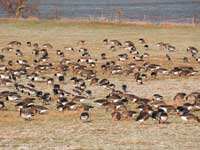
migrating birds form mixed
groups with other migratory
bird species, making them
vulnerable to viruses
Images courtesy of Jan Visser,
NIOO-KNAW
Migratory birds are being regarded with great suspicion as H5N1 spreads rapidly. Their food availability fluctuates seasonally; for this and other reasons, migratory birds travel enormous distances – up to 30 000 km annually – and can disperse pathogenic micro-organisms such as viruses. Many migratory birds cross each other’s paths, forming a network of migratory routes and resulting in contact between many species and populations. Depending on the extent of contact between migratory birds and the way in which birds infect each other, viruses may ultimately spread across the world. Thus the infection route is determined to a large extent by the specific ecology of the pathogen and the host.
Sick birds
Ecological research is necessary for us to understand how the bird flu virus is distributed in a bird population, the location of infection, the transmission and the effects influenza viruses have on their migratory host. To this end, ecologists at the Netherlands Institute of Ecology study migratory water birds, such as the Bewick’s swan. The scientists collect faeces and take swabs or cloacal samples, observe the birds’ behaviour and study the food intake and diet of this small swan.
The faeces and swabs are then sent to virologists at the Erasmus Medical Centre, who analyse them for pathogens like influenza viruses. By doing this, the researchers aim to make an inventory of which hosts carry which influenza subtype.

Anas acuta, is widespread in
the north of Europe, Asia, and
North America. In winter, it
flies south as far as the
equator. Outside the
breeding season, this social
duck forms mixed groups
with other species of duck
Image courtesy of Jan Visser,
NIOO-KNAW
So far, only LPAI viruses have been found. Until recently, scientists did not know that birds could become ill from an LPAI infection: only HPAI viruses were thought to cause symptoms such as sudden death, oedema in head and neck, diarrhoea, subcutaneous haemorrhages, loss of appetite, lethargy, and respiratory problems. However, this year the ecologists found two LPAI-infected swans (infected with H6N2 and H6N8) that began their spring migration more than a month behind schedule. Jan van Gils explains: “When we found the infected birds, they were in poor condition. They ate less and had poor digestion, resulting in less stored fat. We are curious about the condition in which these two infected swans will return in winter and whether they will produce offspringprdquo; Hopefully, the knowledge acquired on the LPAI will contribute to the HPAI research.
High-tech collar
To predict the continuing spread of bird flu, it is crucial to study migratory routes. At the Netherlands Institute of Ecology, data is collected by the Dutch Ringing Centrew4 to study the routes of migratory birds in co-operation with other European countries. Numerous bird species are captured and ringed by volunteers. The light metal ring is a bird’s passport: if someone finds a ringed bird, they inform the Ringing Centre. In this way, individual birds can be tracked and the flight routes of different species obtained. The route of the Bewick’s swan is also studied by fitting some of these swans with a global positioning system (GPS) collar, which allows the birds to be traced more accurately. Some other species of water birds are followed in a similar way by other ecologists (see image), and the information on these flight routes is compared with the hotbeds of H5N1 outbreaks.
How do bird flu viruses spread?
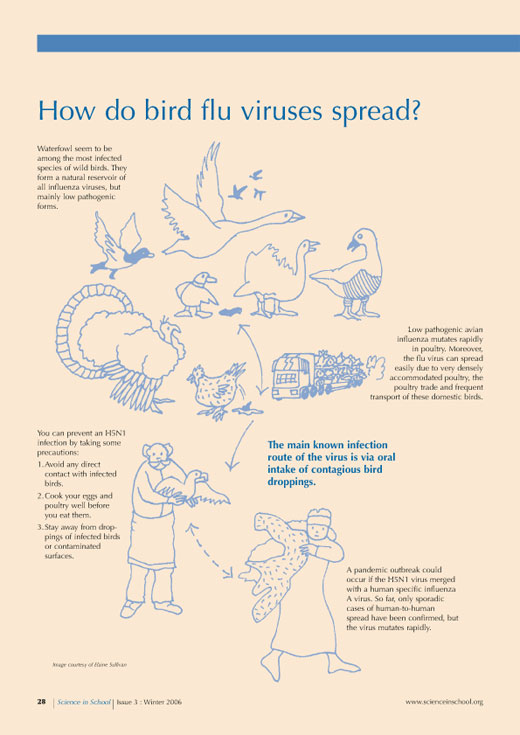
The core of the problem
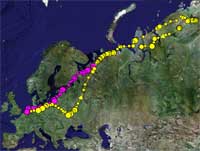
collars can be traced at all
times. The pink dots
represent the path of the
white-fronted goose Harry;
the yellow dots show that of
Adri. Examples of live
tracking satellite pictures are
available online
So far, migratory water birds have received the most attention as health hazards. They are considered by many to be the main or even the only virus vectors infecting people and poultry, but solid scientific evidence is lacking. Ecologist Marcel Klaassen says, “There is a lot of hysteria about the role migratory birds play. Perhaps because this distracts the attention from the real core of the problem: the very densely kept poultry, constituting a virus’s paradise. And due to trade, poultry is transported very frequently and extensively. In these ways, the flu virus can spread easily.”
Furthermore, virologists from the Erasmus Medical Centre found that LPAI infections naturally present in wild migratory birds are stable, unlike the rapidly mutating LPAI viruses found in poultry. In summary, migratory birds are involved in the spread of bird flu, as victims but not necessarily as offenders.
Research need to continue into the role that migratory birds and poultry play in the spread of influenza virus before people like Zhirinovski advocate harming migratory birds. In particular, the exact link between host and infecting influenza virus should be investigated.
Eco-factsheets

The Netherlands Institute of Ecology offers up-to-date ecological information in eco-factsheets. The first factsheet deals with the ecology of bird flu and is tailored to secondary school students, for use in school assignments such as reports, experiments, presentations and preparations for debate. Biology teachers can find supplementary ecological information on topical subjects from the associated website.
The eco-factsheets contain:
- Background on current ecological themes
- Supporting graphics and pictures
- Online quizzes or other challenges
- Information on, or interviews with, researchers
- Future research questions
- Links, e.g. to short movies.
The eco-factsheet The Ecology of Bird Fluis available in English and Dutch.
Web References
- w1 – The Netherlands Institute of Ecology focuses on basic and strategic research into individual organisms, populations, ecological communities and ecosystems.
- w2 – The Erasmus Medical Centre in Rotterdam is the largest university medical centre in the Netherlands.
- w3 – The World Health Organization (WHO) is the United Nations specialised agency for health
- w4 – The Dutch Ringing Centre administers almost everything concerning rings on wild birds in the Netherlands.
Review
In the last three years, bird flu has captured people’s attention more than any other disease. Frequent updates on its spread and victims have been routinely included in the news, alarming scientists, governments and the lay public. As expected, student curiosity regarding bird flu is also on the rise.
This article provides the reader with a brief but useful account of the scientific specifics of bird flu with a focus on the role played by migratory birds in the spread of the disease.
The information in the article could serve directly as a means of satisfying students’ curiosity. Additionally, it could inspire teachers and students to design small investigations to collect additional information concerning the role of migratory birds as vectors of the deadly bird flu virus. Group projects could be aimed at gathering data to determine whether migratory birds are, as accused, good candidates for spreading bird flu and eventually causing a global outbreak. Other investigations could focus on what measures could be taken to prevent the disease from spreading to even more parts of the world.
The nature and subject of these investigations make them ideal for interdisciplinary studies. For example, biology and geography could be combined to shed more light onto the facts and myths surrounding the correlation between migratory birds and bird flu outbreaks.
Michalis Hadjimarcou, Cyprus





